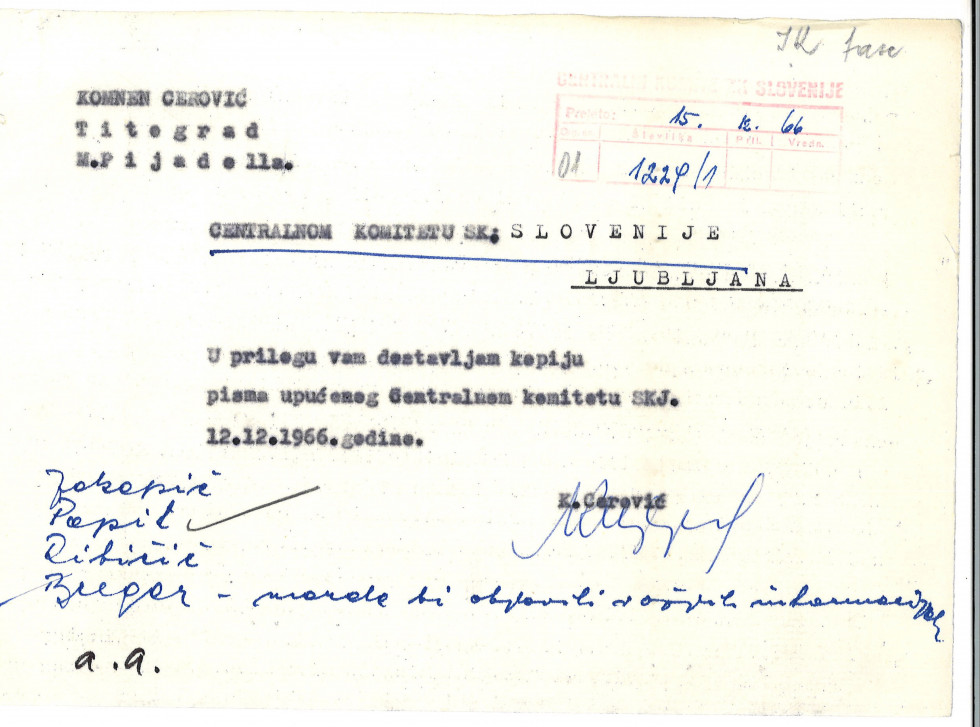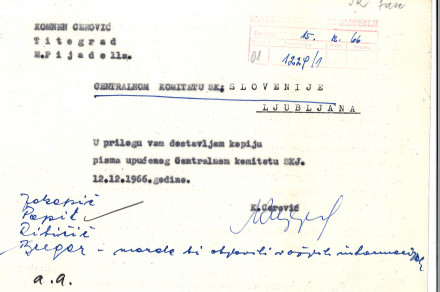Reactions to the Đilas Affair in Yugoslavia and Abroad
Titograd (Podgorica), December 12, 1966
Typescript, copy of the letter in the Serbian language, 9 pages
Reference code: SI AS 1589/IK, Centralni komite Zveze komunistov Slovenije, box 43, unit of description 42

Komnen Cerović's letter about Đilas to the Central Committee of the Union of Communists of Slovenia. | Author Arhiv Republike Slovenije
»I Wasn't Even Trying to Come to Power, I Just Wanted to Criticize …«
This month's archivalia is a lengthy letter written by the Montenegrin partisan and national hero Komnen Cerović (1916-2000) and sent at the end of 1966 to the Central Committee of the League of Communists of Yugoslavia to which Cerović had unsuccessfully sent a similar letter already a couple of months earlier. The letter presented here was simultaneously also sent for the information of the Central Committee of the League of Communists of Slovenia and copies of it were sent to all of the Yugoslav republic central committees. Cerović titled his letter with a question of why his compatriot and friend Milovan Đilas (1911-1995) was after nine years still kept in a Yugoslav prison. In his letter, Cerović was very critical of the Yugoslav authorities and media, which he believed had been dismissing Đilas's ideas and obstructing his actions in every possible way for the previous thirteen years.
Milovan Đilas, a politician, writer and a pre-war communist, was a close associate of Tito from 1940 to the start of 1954. During and after WW2, he was a member of the Yugoslav Party Politburo (alongside Tito, Edvard Kardelj and Aleksandar Ranković), a member of the Chief Headquarters and the editor of the Party newsletter Borba. In 1944, he visited Stalin in Moscow for the first time, and then made several more trips to Moscow until 1948. However, in spite of this or perhaps precisely because of this, Đilas became a strong anti-Soviet ideologist in the Informbiro conflict following the Tito-Stalin split and laid down theoretical foundations for the independent Yugoslav Party, despite being an ardent supporter of Stalin before that. The 1952 renaming of the party from the Communist Party of Yugoslavia to the League of Communists of Yugoslavia is said to have largely been his idea. As an intellectual- before the war he was attending the Faculty of Arts in Belgrade – he spoke Russian, French, English and also German. In 1953, he was appointed the vice-president of the Yugoslav Government and by the end of the same year the President of the Federal Assembly. His political ascend made him the second most powerful man in Yugoslavia, just after Tito. However, by the end of 1953, dark clouds began to gather over him and his political future. He began to advocate democratization of the Party authority, which did not sit well with the majority of the Party leaders.
It was then that he decided to leave his narrow and closed circles of the Party and begin publishing his articles in the newsletter Borba and in a cultural monthly Nova misel. From October 8, 1953 to January 7, 1954, nineteen of his articles were published in the newsletter Borba, all of them exposing his radical ideas. In his articles, Đilas criticized “the placing of the Party above the law and preventing any democratic dialogue from taking place in the society”. He went as far as to stand up for the formation of a political opposition to the ruling Party. At first, there was no reaction from the political top establishment and no one protested. Borba had a large circulation; at first his articles were published once a week, and later even as often as three times a week due to the positive response of his readers. At the end of 1953, Đilas received a message saying that Tito was very mad at him, so he decided to publish another one of his articles in the newsletter Nova misel. The article entitled Anatomija neke morale (Anatomy of a Moral) came out in January 1954 and was a devastating critique of the ruling elite. In a literary piece of writing, he portrayed the attitude of the Party elite towards a young actress, who was married to a high-ranking official, but was never accepted by the female part of the elite because she did not belong to the partisan circles. It was easy for everyone to recognize in this story the characters of the Montenegrin General Peko Dapčević and his young wife Milena.
After that, events happened very quickly. An extraordinary plenary meeting of the League of Communists of Yugoslavia was called on January 16 and 17, 1954, where Đilas was accused of revisionism and an attempt to liquidate the Party and restore capitalism. The only one defending Đilas was Vladimir Dedijer. Everything was taken from Đilas; he lost his salary, his political position, he was expelled from the Central Committee, he left the League of Communists of Yugoslavia, he was even stripped of his title of a national hero and his rank of a general. Đilas – the same as Dedijer – was not able to obtain his passport for a long time and, even worse, no one wanted to know him anymore on the street. Although they let him live, he was politically dead in Yugoslavia until 1990. His work was not allowed to be published in Yugoslavia, so he was forced to turn to the West or, more precisely, the West turned to him. It wasn’t long before the American and West European media began publishing interviews with Đilas as a dissident. He dedicated his time to write a book called Novi razred (The New Class), which came out in 1957 in New York and became an international best seller. The book is believed to have been published using the funds of the American intelligence service CIA. At the end of 1956, he was arrested at his home for criticising Yugoslav support for the Soviet suppression of the uprising in Hungary in the foreign press. He was in prison until January 1961 and then released on parole. In 1962, he resurfaced in the West with his new book Razgovori s Stalinom (Conversations with Stalin), in which he described his meetings with the former Soviet leader. The Yugoslav political leadership reacted immediately, this time to protect the newly formed amicable relations between Yugoslavia and the Soviet Union. Đilas was again sent to prison and was charged with a five-year prison sentence.
In his letter, Cerović repeatedly mentioned Đilas’s ideas, but this time they were described in the light of new events taking place after the plenary meeting in Brioni in the summer of 1961, when the head of the federal State Security Agency and Đilas’s former opponent Aleksandar Rankovič was forced to leave the Yugoslav political stage. Among other things, Cerović also quotes from the article Razredni boj, which was published in Borba on December 31, 1953:”The enemy of the socialism and democracy is not only bourgeoisie, but also bureaucracy, which is constantly breaking the law, trying to establish ideological and political domination over people so that it can spend their resources at its own free will and which, in order to justify its existence and demonstrate loyalty to itself and its own dogma, often also invents the idea of an enemy. “
On December 31, 1966, Đilas was released from prison before the end of his sentence, after a total of nine and a half years behind bars, partly perhaps also thanks to the Cerović’s letter. At the end of the 1960s, he finally received his passport and went and held lectures in the USA and in Britain. He did not choose to become an emigrant, but instead returned to his home country where his passport was again taken from him for another two decades. He became something of a world icon and the Yugoslav authorities no longer dared to pursue him in court. Some Western politicians even stood up for him in their talks with Tito, but always within the realm of realpolitik. Silence concerning Đilas in the Yugoslav political and media space did not really subside until March 9, 1987, when the Maribor student newspaper Katedra published an interview with him. The interesting thing in all of this is that Đilas never renounced socialism; we could characterize him as a reformed communist who stood for democratic socialism. The quote in the title, which describes Đilas’s somewhat impulsive character, is actually taken from his interview with Lado Ambrožič for the Slovenian television.
Mojca Tušar
- Perović, Latinka: Dominantna i neželjena elita. Beleške o intelektualnoj i političkoj eliti u Srbiji (XX – XXI vek). Beograd: Dan Graf, 2016, pp. 263–297.
- Režek, Mateja: Med resničnostjo in iluzijo. Slovenska in jugoslovanska politika v desetletju po sporu z Informbirojem (1948–1958). Ljubljana: Modrijan 2005, pp. 133–149.
- Đilas, Milovan: Novi razred. Analiza komunističnega sistema. Ljubljana: Inštitut Nove revije, 2014, pp. VII–XXII.
- Đilas, Milovan: Anatomija neke morale in 19 znamenitih člankov (oktober 1953–januar 1954). Ljubljana: Inštitut Nove revije, 2015, pp. 65–66, 133–182.
- Balantič, Polona: Fenomen Đilas – od položaja ob Titu do izobčenega disidenta je le 17 člankov.


